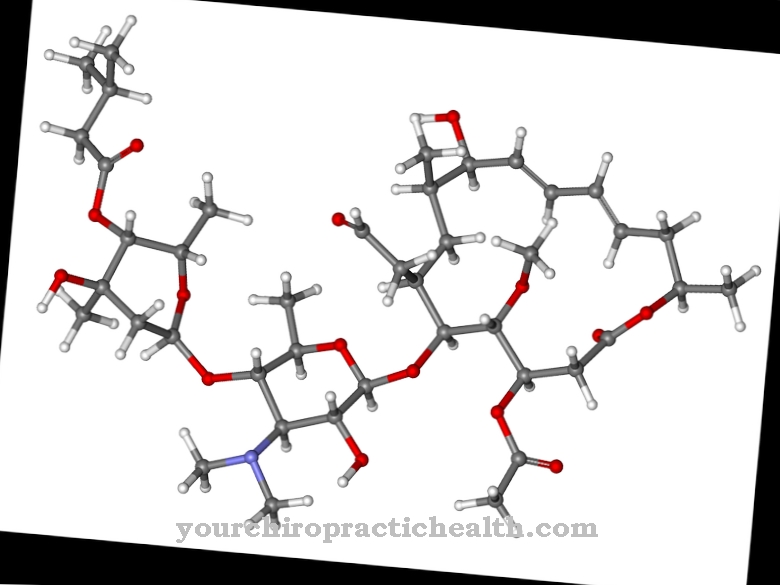Benzodiazepines are special chemical compounds (compounds of a benzene ring with a diazepine ring) that develop psychotropic effects in the body. They are used in medicine as anxiolytic, central muscle relaxing, calming (sedating) and sleep-promoting (hypnotic) drugs. The anticonvulsant effect of some benzodiazepines also explains their use as anti-epileptic drugs.
What are Benzodiazepines?
All benzodiazpines are derived from the same basic chemical structure. It is a bicyclic ring system consisting of a benzene and a diazepine ring. The benzene ring is the simplest representative of the benzenoid, aromatic hydrocarbons with the empirical formula: C6H6.
A diazepine ring is fused to this (connected by condensation). The diazepine ring is a seven-membered, unsaturated ring with 2 nitrogen atoms. The main drugs used are diazepine rings with nitrogen atoms in the 1st and 4th positions in the ring - so-called benzo-1,4-diazpines. Another six-membered ring is connected at the 5th position of the diazpin ring, but not by fusing.
Different binding sites in the area of the benzene ring, on the diazepine ring and the additional six-membered ring result in different active ingredients, some of which have different effects.
Pharmacological effect
Benzodiazepines have an activating effect on the gamma-amino-butyric acid (GABA) receptor A through binding and thus increase the effect of the neurotransmitter GABA. GABA-A receptors are found throughout the brain and spinal cord. The binding increases the probability of opening the GABA-A receptor, which leads to an increased influx of chloride into the nerve cell. This hyperpolarizes the neuron membrane, which leads to a lower level of excitability.
The GABA-A receptor consists of 6 subunits, with classic benzodiazepines showing affinity for 4 of these subunits (alpha1, alpha2, alpha3 and alpha5). An effect on the receptor is only possible if the neurotransmitter GABA is present - they are therefore allosteric modulators and not agonists in the narrower sense. The effect is stronger on those synapses that contain little GABA. There is an activity-dependent effect. This means that weak transmitter responses are amplified disproportionately. This could also be responsible for the specific effect of the benzodiazepines.
Benzodiazepines work in the human body:
- Anxiety reliever (anxiolytic)
- Antispasmodic (anticonvulsant)
- Muscle relaxing (muscle relaxing)
- Calming (sedative)
- Sleep-inducing (hypnotic)
- Amnestic (memory gap during the duration of action)
- Slightly mood-enhancing (attention: if you have an underlying depressive illness, it can also intensify)
- Partly euphoric (dose-dependent and dependent on the intake interval)
The maximum effect is not increased by high doses of benzodiazepines. However, the necessary dose of GABA is reduced in order to trigger the maximum effect. So the dose-effect curve of gamma-amino-butyric acid is shifted to the left.
Medical application & use
Because of the achievable effects, benzodiazepines are mainly used in emergency medicine and in psychiatry. The possible areas of application are, however, clearly limited by the high potential for dependence and the strong respiratory depressive side effects.
With regular use for about 8 weeks or more, withdrawal symptoms occur when the drug is discontinued. It is therefore recommended not to use benzodiazepines for longer than 4 weeks (provided that the indication is strict and the dosage is as low as possible).
The antiepileptic benzodiazepines, which often have to be taken for life, are an exception. The active ingredients diazepam and lorazepam are particularly suitable as agents of first choice for the treatment of acute epileptic seizures.
In psychiatry, benzodiazepines are mainly used in the treatment of anxiety and restlessness. They are also often used as acute medication for panic attacks.
Benzodiazepines also have a firm place in the treatment of alcohol withdrawal symptoms. Benzodiazepines can also be used in the short-term therapy of difficulty falling asleep and staying asleep. Due to the potential for dependence, however, other substance groups (such as antihistamines) are increasingly preferred.
In emergency medicine, benzodiazepines are also used to induce anesthesia and as part of pain therapy (analgesic sedation). In selective interventions, premedication is often carried out with a benzodiazepine such as midazolam before the operation in order to relieve the patient of the tension and possible fear of the operation.
Risks & side effects
Benzodiazepines have different degrees of respiratory depression by dampening the respiratory center in the elongated spinal cord. Although respiratory depression occurs in a dose-dependent manner, life-threatening intoxication from benzodiazepines alone is rare. Especially in the case of mixed intoxication together with alcohol or other CNS-effective preparations (e.g. opiates), there is a significantly increased risk of fatal respiratory arrest.
The interaction between benzodiazepines and alcohol is referred to as cross-tolerance due to the similar effect on the GABA-A receptor. Increasing the dose, which is often practiced in response to increased tolerance, leads to increased side effects.
The addictive potential of benzodiazepines is evident in the severe physical dependence that occurs even at therapeutic doses. It is therefore not surprising that benzodiazepines have the highest rates of abuse worldwide. There are then disorders of the memory function, behavior disorders, psychomotor slowdown and paradoxical effects (increase in anxiety and / or sleep disorders) under the medication.
The contraindications to taking benzodiazepines include:
- Myasthenia gravis (disorder of neuromuscular impulse transmission)
- Ataxia (disorder of movement coordination)
- Angle-closure glaucoma (glaucoma)
- Existing addiction disease (also in the past)
- Allergy to the active ingredient
- Sleep apnea syndrome (breathing pauses during sleep)



























